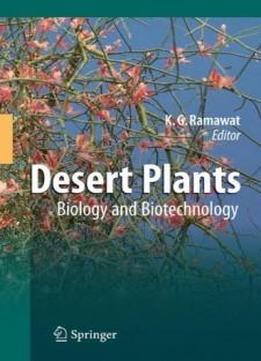
Desert Plants: Biology And Biotechnology
by Kishan Gopal Ramawat /
2010 / English / PDF
9.1 MB Download
Deserts appear very fascinating during our short visits. However,
the lives of plants and animals are very dif?cult under the harsh
climatic conditions of high tempe- ture and scant water supply in
deserts, sometimes associated with high concent- tions of salt. The
editor of this book was born and brought up in the Great Indian
Desert, and has spent much of his life studying the growth and
metabolism of desert plants. It is very charming on a cool summer
evening to sit at the top of a sand dune listening only to blowing
air and nothing else. It has been my dream to prepare a volume on
desert plants encompassing various aspects of desert plant biology.
In this book, I have tried to present functional and useful aspects
of the vegetation resources of deserts along with scienti?c input
aimed at understanding and impr- ing the utility of these plants.
The scant vegetation of deserts supports animal life and provides
many useful medicines, timber and fuel wood for humans. Therefore,
there are chapters devoted to medicinal plants (Chap. 1),
halophytes (Chaps. 13, 14), and fruit plants (Chaps. 17, 20).
Desert plants have a unique reproductive biology (Chaps. 9–11),
well-adapted eco-physiological and anatomical charact- istics
(Chap. 7), and specialised metabolism and survival abilities. These
plants are dif?cult to propagate and pose many problems to
researchers developing biote- nological approaches for their
amelioration (Chaps. 18–20).
Deserts appear very fascinating during our short visits. However,
the lives of plants and animals are very dif?cult under the harsh
climatic conditions of high tempe- ture and scant water supply in
deserts, sometimes associated with high concent- tions of salt. The
editor of this book was born and brought up in the Great Indian
Desert, and has spent much of his life studying the growth and
metabolism of desert plants. It is very charming on a cool summer
evening to sit at the top of a sand dune listening only to blowing
air and nothing else. It has been my dream to prepare a volume on
desert plants encompassing various aspects of desert plant biology.
In this book, I have tried to present functional and useful aspects
of the vegetation resources of deserts along with scienti?c input
aimed at understanding and impr- ing the utility of these plants.
The scant vegetation of deserts supports animal life and provides
many useful medicines, timber and fuel wood for humans. Therefore,
there are chapters devoted to medicinal plants (Chap. 1),
halophytes (Chaps. 13, 14), and fruit plants (Chaps. 17, 20).
Desert plants have a unique reproductive biology (Chaps. 9–11),
well-adapted eco-physiological and anatomical charact- istics
(Chap. 7), and specialised metabolism and survival abilities. These
plants are dif?cult to propagate and pose many problems to
researchers developing biote- nological approaches for their
amelioration (Chaps. 18–20).











